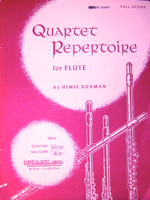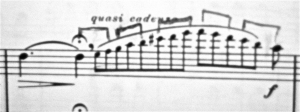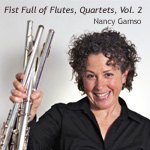Fist Full of Flutes, Quartets, Vol. 2
These quartets for four C flutes are appropriate for intermediate to advanced flutists and also work well for casual classical gigs, sight-reading and adult amateurs. All are published in the Rubank, Quartet Repertoire for Flute, edited by Himie Voxman. The quartets range in style from Baroque and Classical (Rameau, Haydn) to Romantic and Modern (Rimsky-Korsakov, Debussy). Complete publishing information can be found below.
Tracks for each piece below are available separately as high-quality mp3 files.
Or, download the entire set (single zip file): Flute-Quartets-Vol.-2

Voxman, H., editor; Quartet Repertoire, Rubank/Hal Leonard, 2159-47 No. 4
Debussy, Sarabande
Composer Highlights
Practice Suggestions
There are many places where the four lines are in unison. I took most of the vibrato out except for the first part. Try it different ways and see which seems the most beautiful and the least distracting. You will notice that I made 4-bar phrases. Sometimes the music calls for a longer line, so at these times I did catch breaths, short sips that don’t take long and are hardly detectable to the listener (that is when they aren’t sitting 3 feet from your mouth, as the microphone was from mine).
Several times the 3rd and 4th parts have the interesting parts, make sure your balance supports those parts being in the forefront. The chords at mm. 59 and the end are probably the most challenging to tune. If you haven’t already, watch the tuning video to get some tips on intonation in flute ensembles. This selection was in the top five favorite pieces for Jeff, the recording engineer, of the sixty that we recorded, so it comes with high praise – enjoy!
Download Tracks
01-Debussy Sarabande Quartet Repertoire complete version
02-Debussy Sarabande Quartet Repertoire minus 1st part
03-Debussy Sarabande Quartet Repertoire minus 2nd part
04-Debussy Sarabande Quartet Repertoire minus 3rd part
05-Debussy Sarabande Quartet Repertoire minus 4th part
Download all five tracks (single zip file)
No. 6: Haydn, Andante and Allegro Assai
Composer Highlights
Practice Suggestions
 Speaking of rhythm, also notice that not just the first but all the grace-note ornaments are played on the beat, not before. For the Allegro assai, the syncopation can be problematic for inexperienced players. Shorten the notes and practice without the 1st part to get the “motor” solid as a freight train. This movement may require a great deal of individual metronome practice and rehearsals in twos. The play alongs will help too, of course!
Speaking of rhythm, also notice that not just the first but all the grace-note ornaments are played on the beat, not before. For the Allegro assai, the syncopation can be problematic for inexperienced players. Shorten the notes and practice without the 1st part to get the “motor” solid as a freight train. This movement may require a great deal of individual metronome practice and rehearsals in twos. The play alongs will help too, of course!
This is a lovely selection of two contrasting movements and we use it often for gigs. I believe that you will have fun working on it. Concerning part assignments – make sure that you have a strong player on 4th part. Both the Andante and the Allegro assai need a big, solid low flute sound for the bass line and bass melodies throughout these movements.
Download Tracks
06-Haydn Andante Quartet Repertoire complete version
07-Haydn Andante Quartet Repertoire minus 1st part
08-Haydn Andante Quartet Repertoire minus 2nd part
09-Haydn Andante Quartet Repertoire minus 3rd part
10-Haydn Andante Quartet Repertoire minus 4th part
11-Haydn Allegro Assai Quartet Repertoire complete version
12-Haydn Allegro Assai Quartet Repertoire minus 1st part
13-Haydn Allegro Assai Quartet Repertoire minus 2nd part
14-Haydn Allegro Assai Quartet Repertoire minus 3rd part
15-Haydn Allegro Assai Quartet Repertoire minus 4th part
Download all ten tracks (single zip file)
No. 7: Rimsky-Korsakoff, Here Is A Fish Fat and Fine
Composer Highlights
Did you know that this is the composer who brought us Flight of the Bumblebee? He was a self-taught musician who was hired as a composition professor and even wrote a book on harmony while secretly self teaching himself the very subject he was instructing. He was fired for being sympathetic to the revolutionary students (the same revolution that inspired my Jewish great-grandparents to move to America) only to be reinstated and then wrote an opera mocking the authorities. I like this guy! In 1876 and ’77, Nikolay edited a book of 100 Russian Folk Songs and soon after he began to infuse his compositions with folk music traits. I had hoped to find this folk song there but alas, it was not included. I even talked to a Russian immigrant whose mother played Russian folk music on an accordion but he didn’t know it either. I did hear ‘Here Is A Fish, Fat and Fine’ performed vocally once almost twenty years ago, in Russian, by a group of Russian folk musicians who were visiting Ohio Wesleyan. They sang it very slowly and I remember how interesting the Russian syllables sounded, spilling over one another.
Practice Suggestions
Download Tracks
16-Rimsky Korsakoff Here Is A Fish Fat and Fine Quartet Repertoire complete version
17-Rimsky Korsakoff Here Is A Fish Fat and Fine Quartet Repertoire minus 1st part
18-Rimsky Korsakoff Here Is A Fish Fat and Fine Quartet Repertoire minus 2nd part
19-Rimsky Korsakoff Here Is A Fish Fat and Fine Quartet Repertoire minus 3rd part
20-Rimsky Korsakoff Here Is A Fish Fat and Fine Quartet Repertoire minus 4th part
Download all five tracks (single zip file)
No. 9: Rameau, The Village Maid
Composer Highlights
Practice Suggestions
Download Tracks
21-Rameau The Village Maid Quartet Repertoire complete version
22-Rameau The Village Maid Quartet Repertoire minus 1st part
23-Rameau The Village Maid Quartet Repertoire minus 2nd part
24-Rameau The Village Maid Quartet Repertoire minus 3rd part
25-Rameau The Village Maid Quartet Repertoire minus 4th part
Download all five tracks (single zip file)
No. 11: Dvoràk, The Sparrow’s Party
Composer Highlights
Dvoràk big break was in 1878 when in a few weeks’ time, he became the most famous composer in Europe. This is when his Slavonic Dances, Op. 46 were published and, as one journal reported, caused “a positive assault on sheet music shops”. Within a few months, five major orchestras, including New York, were performing his music and all the most famous conductors and violinists were his new best friends.
For a few years, Dvoràk ended up in New York, as artistic director and composition professor at the National Conservatory of Music, with a salary of $15,000 – an amount five times what he had been making teaching in Prague, $364,000 in today’s dollars. It was interesting just how much his time in America affected him. Listen to the Largo movement of the New World Symphony and tell me you don’t hear a spiritual. Listen to the American String Quartet and tell me you don’t imagine the hilly fields of Iowa, where he composed it. He was here, traveling around our country, capturing just what Jeanette Thurber, the President of the National Conservatory, hoped he would – a true American classical music. Dvoràk wrote and arranged over 100 folk songs for voices. Here is a snippet of the original of “The Sparrow’s Party”, the fifth movement from Five Choral Songs for Male Voices to Lithuanian Folk Song Texts, Op. 27 B 87, composed in 1878 and published in 1890. The Sparrow’s Party is track 20.
Practice Suggestions
Download Tracks
26-Dvorak The Sparrows Party Quartet Repertoire complete version
27-Dvorak The Sparrows Party Quartet Repertoire minus 1st part
28-Dvorak The Sparrows Party Quartet Repertoire minus 2nd part
29-Dvorak The Sparrows Party Quartet Repertoire minus 3rd part
30-Dvorak The Sparrows Party Quartet Repertoire minus 4th part
Download all five tracks (single zip file)

